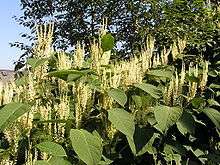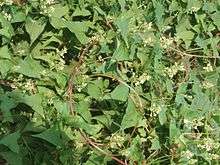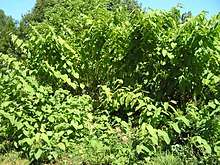Reynoutria
Reynoutria is a genus of flowering plants in the family Polygonaceae. The genus is native to eastern China, Eastern Asia and the Russian Far East, although species have been introduced to Europe and North America.[1] Members of the genus, including R. japonica (Japanese knotweed) and its hybrid with R. sachalinensis, are highly invasive plants.
| Reynoutria | |
|---|---|
 | |
| Japanese knotweed, Reynoutria japonica | |
| Scientific classification | |
| Kingdom: | Plantae |
| Clade: | Tracheophytes |
| Clade: | Angiosperms |
| Clade: | Eudicots |
| Order: | Caryophyllales |
| Family: | Polygonaceae |
| Subfamily: | Polygonoideae |
| Genus: | Reynoutria Houtt.[1] |
Description
Species placed in the genus Reynoutria are robust erect perennial plants, growing from rhizomes. They are usually monoecious, with mostly bisexual flowers, but also some unisexual flowers. The petals of the flowers are dry and paperlike when mature. The fruits are achenes with threefold sharp edges. The inflorescence is in the form of a panicle. The flowers have separated triangular stigmas with fringes (fimbriate) borne on long divided styles.[2]
Taxonomy
The genus Reynoutria was erected by Maarten Houttuyn in 1777 for the species R. japonica. It was named in honour of Herr von Reynoutre who had been reported to have done a great deal of service to botany.[3][4] As with many species in the family Polygonaceae, the taxonomic boundaries of Reynoutria have been much confused; in particular, it has been repeatedly merged with and separated from Fallopia.[5] A series of molecular phylogenetic studies have clarified relationships; Reynoutria is a well-supported monophyletic taxon.[6][7][8][2][9][5]
Reynoutria is placed in the tribe Polygoneae of the subfamily Polygonoideae. Within the tribe, it is most closely related to the genera Muehlenbeckia and Fallopia s.s., forming the so-called "RMF clade".[5]
| Polygoneae |
| ||||||||||||||||||||||||||||||||||||||||||
Species


As of February 2019, Plants of the World Online recognized the following species:[1]
- Reynoutria × bohemica Chrtek & Chrtková
- Reynoutria ciliinervis (Nakai) Moldenke
- Reynoutria japonica Houtt. – Asian knotweed, Japanese knotweed
- Reynoutria multiflora (Thunb.) Moldenke – Chinese knotweed
- Reynoutria sachalinensis (F.Schmidt) Nakai – giant knotweed, Sakhalin knotweed
Invasive potential
All members of the RMF clade appear to have the potential to become invasive, in some cases via vigorous hybrids. Reynoutria japonica is highly invasive throughout Europe and North America. The hybrid between R. japonica and R. sachalinensis, R. × bohemica, is also invasive, particularly in North America. R. japonica hybridizes with the New Zealand Muehlenbeckia australis. (The related M. complexa has established populations in southern parts of Britain and in the Channel Islands.)[5]
References
- "Reynoutria Houtt.", Plants of the World Online, Royal Botanic Gardens, Kew, retrieved 2019-02-25
- Schuster, T.M.; Wilson, K.L. & Kron, K.A. (2011), "Phylogenetic relationships of Muehlenbeckia, Fallopia and Reynoutria (Polygonaceae) investigated with chloroplast and nuclear sequence data", International Journal of Plant Sciences, 172: 1053–1066, doi:10.1086/661293, JSTOR 10.1086/661293
- "Plant Name Details for Reynoutria Houtt.", The International Plant Names Index, retrieved 2019-03-03
- Houttuyn, M (1777) [1720-1798], "Reynoutria", Natuurlyke historie of Uitvoerige beschryving der dieren, planten, en mineraalen, 2, pp. 639–640, retrieved 2019-03-03
- Schuster, Tanja M.; Reveal, James L.; Bayly, Michael J. & Kron, Kathleen A. (2015), "An updated molecular phylogeny of Polygonoideae (Polygonaceae): Relationships of Oxygonum, Pteroxygonum, and Rumex, and a new circumscription of Koenigia", Taxon, 64 (6): 1188–1208, doi:10.12705/646.5
- Sanchez, A.; Schuster, T.M. & Kron, K.A. (2009), "A largescale phylogeny of Polygonaceae based on molecular data", International Journal of Plant Sciences, 170: 1044–1055, doi:10.1086/605121
- Sanchez, A.; Schuster, T.M.; Burke, J.M. & Kron, K.A. (2011), "Taxonomy of Polygonoideae (Polygonaceae): A new tribal classification", Taxon, 60: 151–160, JSTOR 41059829
- Schuster, T.M.; Reveal, J.L. & Kron, K.A. (2011), "Evolutionary Relationships within Polygoneae (Polygonaceae: Polygonoideae)", Taxon, 60: 1653–1666, cited in Schuster et al. (2015)
- Fan, D.-M.; Chen, J.-H.; Meng, Y.; Wen, J.; Huang, J.-L. & Yang, Y.-P. (2013), "Molecular phylogeny of Koenigia L. (Polygonaceae: Persicarieae): Implications for classification, character evolution and biogeography.", Molecular Phylogenetics and Evolution, 69: 1093–1100, doi:10.1016/j.ympev.2013.08.018